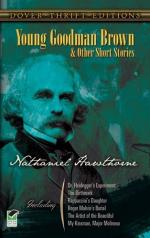|
This section contains 2,050 words (approx. 7 pages at 300 words per page) |

|
SOURCE: “Hawthorne Interprets ‘Young Goodman Brown,’” in ESQ: A Journal of the American Renaissance, Vol. 62, Winter, 1971, pp. 2-4.
In the following essay, Whelan argues that, unlike The Scarlet Letter, in “Young Goodman Brown” Hawthorne leaves no possibility of redemption for the protagonist at the conclusion of the tale, for Brown's “self-inflicted nightmare” haunts him until his death.
Though we have good explications of “Young Goodman Brown,”1 the best and most succinct is Hawthorne's, appearing as a description of Hester Prynne's moral state in the penultimate paragraph of Chapter V of The Scarlet Letter: “Her imagination was somewhat affected, and, had she been of a softer moral and intellectual fibre, would have been still more so, by the strange and solitary anguish of her life. Walking to and fro, with those lonely footsteps … it now and then appeared to Hester,—if altogether fancy, it was nevertheless too potent to...
|
This section contains 2,050 words (approx. 7 pages at 300 words per page) |

|


